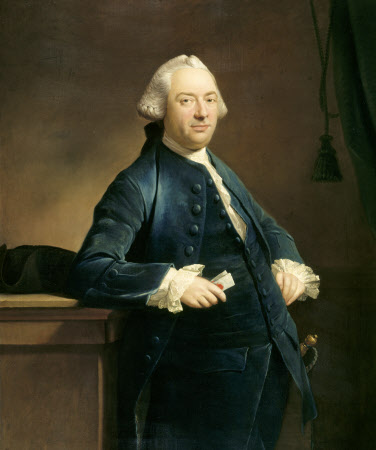Richard Willis (1724-1780)
possibly Mason Chamberlain the Elder (1727 - 1787)
Category
Art / Oil paintings
Date
circa 1760
Materials
Oil on canvas
Measurements
1270 x 1016 mm (50 x 40 in)
Order this imageCollection
Clevedon Court, North Somerset
NT 624176
Summary
Oil painting on canvas, Richard Willis (1724-1780), attributed to Robert Edge Pine (London 1730 – Philadelphia 1788), possibly Mason Chamberlin, the elder RA (London 1727 – Dorset 1787), circa 1760. A three-quarter-length portrait of a middle-aged man, turned to the right, gazing at spectator, his left hand on his hip, his arm leadning on a pedestal right and holding a paper with a red seal. He is wearing a powdered wig, tied at the back with a black ribbon and wears a blue velvet suit with blue buttons, blue waistcoat and blue breeches. He also has on a white shirt with simple stock, frilled front and frilled cuffs. Indistinct background but with a drape and long tassel seen on the right. Richard Willis was of Fern Hall, Essex. He married Bethia Legge (1734-1778); parents of James Legge Willis (1761-1817) and grandparents of Rhoda Susan Willis (1809-1873) the first wife of Sir Arthur Hallam Elton, 7th Bt, MP (1818-1883). A Turkey merchant of the Levant Co., he went bankrupt in 1778 owing to the French Wars and was, sent by his creditors to Grenada and died of wounds at the siege of Grenada 1780.
Provenance
Bequest of Colonel Richard ffolliot Willis, 1956 formerly lent to Lydiard Tregoze, Swindon; transferred to Clevedon Court in 1984
Credit line
Clevedon Court, the Col. Richard ffolliot Willis Collection (National Trust)
Makers and roles
possibly Mason Chamberlain the Elder (1727 - 1787), artist attributed to Robert Edge Pine (London 1730 – Philadelphia 1788), artist previously catalogued as attributed to Allan Ramsay (Edinburgh 1713 - Dover 1784), artist previously catalogued as attributed to British (English) School, artist previously catalogued as attributed to William Hoare of Bath, RA (Eye 1707 – Bath 1792), artist
References
Waterhouse 1980: Ellis K. Waterhouse, 'The Willis Family Portraits at Lydiard Park' National Trust Studies, 1980, pp.49-53, p.50. illus. Caption to illustration: "4. Richard Willis (1724-80), canvas 127 cm x 101.6 cm." p.50: "The series of portraits begins with a pair of portraits of the great-great-grandfather of Colonel Willis [Colonel Richard ffolliott Willis (1875-1956)], and a companion pair of his wife. This Richard Willis (1724-80) (Fig.2), who was born in Cumberland, was a Turkey merchant of the Levant, and he married at St Olav's, Hart Street, in 1757, Bethia Legg (1734/5-78) (Fig.3), daughter of William Legg of Atherfield Manor, Isle of Wight. There is a pair of heads in crayons and a pair of half-length in oils (Figs 4 and 5), obviously from the same sittings as the heads and equally clearly by the same artist. The larger pictures bore an old label as by Ramsay, but this attribution was changed to 'probably by Cotes'. However, neither of these attributions is acceptable. They are obviously, in a sense, 'marriage portraits' but need not be quite as early as 1757 and a date not later than the early 1760s seems probable from the costume. The two painters who practised equally in oil and crayons who deserve to be considered are Robert Edge Pine and William Hoare, neither of which has been the object of very close research. I think Pine is the more probable, although they lack the mannerism by which his slightly later portraits can easily be recognised, a sort of slicing of the edge of the forehead which is in half shadow. Richard William went bankrupt in 1778, owing to the French Wars and was sent by his creditors to Grenada to settle his affairs there. He died of wounds received at the siege of Grenada in 1780.
